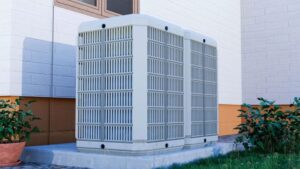Heat Pump Installation & Services in Vista, CA
Society is developing and technologies are improving. Traditional methods of space heating are being replaced by energy-efficient technologies.
These include, among others, heat pumps, which allow modernizing high-temperature heating systems into low-temperature ones. In other words, replace conventional aluminum or cast-iron radiators with a surface temperature of 60°C with water heating floors, warm walls, and fan coils. This will allow you to maintain a comfortable temperature in the room at a coolant temperature of 45 ° C.
Modernizing a heat pump-based heating system will be even more efficient if it is possible to integrate underfloor heating and/or warm walls into the heating circuit.
The comprehensive steps for a complete heat pump installation include preliminary preparations, a site visit with agreement details and contract signing, heating system design, installation of the heating system/boiler room/heat pump, start-up and adjustment, user training, technical supervision, and finally, utilization of the heating system.
Common scenarios for those seeking turnkey heat pump installations include new constructions requiring a complete heating system or situations where a previously purchased heat pump needs installation. Modernization of existing heating systems may also be necessary.
If you’re considering heat pumps to reduce heating costs, engaging the services of a company like Accord Air in Vista, CA is advisable. This avoids the complexity of calculations, hiring multiple teams, and overseeing various aspects of the installation process.

Accord AIR’s installation and replacement
Encompass answering queries, providing expert guidance, assisting in equipment selection and project development, offering advice on affordable heat pump and component procurement, preparing necessary systems, conducting additional tasks like installing warm floors, walls, and fan coils, and providing technical supervision during the initial operational days.
For the purpose of heating, the heat pump draws warmth from the surrounding environment, and its effectiveness increases as ambient temperatures rise. When extracting 7 degrees from the surroundings, it produces an impressive 50 units of heat. The refrigerant undergoes a phase transition, turning into a gas even in sub-zero temperatures. When this gas is compressed in the compressor, it elevates pressure and heat in the system. The heated gas transfers its warmth to utilities, causing the refrigerant temperature to decrease, and the cycle repeats.
In water heating applications, when combined with a boiler in an indirect heating setup, the pump exhibits high efficiency, outperforming an electric boiler by five times in the summer.
Regarding cooling, heaters, in conjunction with fan coil units, are utilized to cool the house.
During heat pump installation, heat storage devices are incorporated into the condenser and compression cycles. The technician connects the electric motor and circulation pipes to the pump. The compressor consumes minimal electricity, mainly for circulating water within the system’s perimeter.
Installation options include hydrological, ground-mounted, or air-mounted configurations. In warmer regions, an air-source pump is preferable, while in other latitudes, ground or water pumps are more suitable. Installing a ground-source pump necessitates either a horizontal collector (covering a 200 m2 area with a 2-meter trench into the ground) or a probe submerged 20 meters into the ground. An open space in the garden must be designated for this purpose.
Hydropumps extract heat from groundwater, with temperatures rarely dropping below 5-7 degrees Celsius. Installing such a device involves laying pipes in the ground near the house for circulating a non-freezing chemical substance.
Heat Pump Installations: Increasingly, Europeans and Americans are incorporating heat pumps into their homes, aligning with the principles of sustainable energy. Heat pumps are advantageous, being autonomous, transportable, silent, and requiring minimal maintenance. They are also fire-safe and can be installed directly within the house.
To install heat pumps, consider engaging specialists from the Accord Air company in Vista, CA.
Why Choose a Heat Pump Over Other Options:
- Gas Prices: The continuously rising cost of gas and the limitations in efficiency improvement technologies are pushing gas equipment aside in favor of heat pumps.
- Stopwatch: Gas pressure drops in cold weather lead to decreased boiler efficiency or even stoppage.
- Gas Quality: Poor gas quality, with excess air and high humidity, results in increased gas consumption by boilers and accelerated clogging of heat pump exchangers by impurities in the gas.

Residential Gas Infrastructure
Bringing gas into a household can be a costly endeavor. Frequently, the expenses associated with establishing gas services to a residence are comparable to those of installing a heat pump system, including the necessary groundwork. This prompts the question of whether relying on gas services and coordinating with neighbors is worth the investment.
- Heightened Risks Associated with Gas Handling
While modern gas boilers are generally dependable, various components such as gas supply lines, filters, and taps introduce potential points of failure. Although the likelihood of a gas leak is low, the risk increases when gas reaches a critical concentration, and the presence of a spark can lead to an explosion.
- Boiler Facilities
Establishing a Boiler Room and its Requirements
When it comes to heat pumps, minimal requirements exist—just an electrical cable and a platform for the heat pump. In contrast, gas boilers are subject to stringent regulations governing the organization of a dedicated boiler room.
Maintenance
- Ongoing Maintenance for Gas Boilers
Similar to a car, a gas boiler demands regular servicing and inspections to ensure proper functionality and tightness. In contrast, a heat pump operates more like a refrigerator, necessitating far less frequent maintenance checks.
